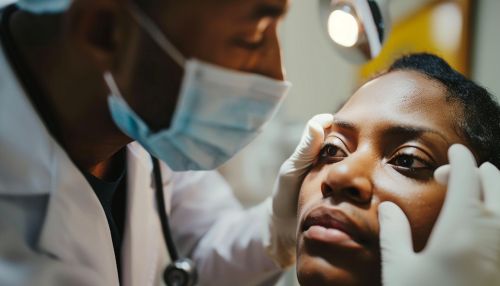Dermatology
Overview
Dermatology is the branch of medicine dealing with the skin, nails, hair and its diseases. It is a specialty with both medical and surgical aspects. A dermatologist is a specialist doctor who manages diseases related to skin, hair, nails, and some cosmetic problems.
History
Dermatology as a distinct branch of medicine was not recognized until the late 18th and early 19th centuries. In 1801, the first school of dermatology was founded in the Hospital Saint-Louis in Paris, while the first textbooks (Willan's, 1798-1808) and atlases (Alibert's, 1806-1814) appeared in the same period.
Branches of Dermatology
Dermatology has many branches, including:
- Medical Dermatology: This branch deals with problems related to the skin, hair, nails, and mucous membranes. Medical dermatologists diagnose and treat conditions like skin cancer, eczema, acne, psoriasis, and rosacea.
- Surgical Dermatology: This branch involves the surgical treatment of skin conditions. Surgical dermatologists may perform procedures such as mohs surgery for skin cancer, cryosurgery, and laser surgery.
- Cosmetic Dermatology: This branch focuses on improving the appearance of the skin, hair, and nails. Cosmetic dermatologists offer treatments like botox, dermal fillers, and chemical peels.
- Dermatopathology: This is a subspecialty of dermatology and pathology that involves the study of cutaneous diseases at a microscopic level.
- Pediatric Dermatology: This branch specializes in the diagnosis and treatment of skin conditions in children.


Common Conditions Treated in Dermatology
Dermatologists diagnose and treat more than 3,000 different diseases. These diseases include skin cancer, eczema, acne, psoriasis, and nail infections. Dermatologists also manage cosmetic disorders of the skin, including hair loss, scars, and the skin changes associated with aging.
Procedures
Dermatologists perform a range of medical and cosmetic procedures, including:
- Biopsies: Skin biopsies are procedures where dermatologists remove a small sample of skin for testing. There are several types of skin biopsies, including shave biopsies, punch biopsies, and excision biopsies.
- Surgical Excision: This is a common procedure in dermatology where a dermatologist removes a skin lesion or part of a skin lesion.
- Cryotherapy: Dermatologists use this treatment to freeze and remove warts, skin tags, and small skin cancers.
- Photodynamic Therapy: This is a treatment that uses a drug, called a photosensitizer, and a particular type of light to kill cancer cells.
- Laser Surgery: Dermatologists use lasers to treat many skin conditions and cosmetic complaints, including wrinkles, scars, warts, enlarged sebaceous glands, and redness and flushing.
Dermatological Diagnostics
Dermatologists use a variety of diagnostic techniques to diagnose skin conditions, including:
- Dermoscopy: This is a non-invasive method that allows the in vivo evaluation of colors and microstructures of the epidermis, the dermoepidermal junction, and the papillary dermis not visible to the naked eye.
- Skin Biopsy: This is a procedure in which a sample of skin tissue is removed, processed, and examined under a microscope.
- Patch Testing: This is a method used to diagnose skin allergies.
- Skin Culture: This is a laboratory test to identify and diagnose infections that may be causing skin symptoms.
Future of Dermatology
The future of dermatology looks promising with the advent of new technologies and treatments. Developments in genetic research have led to the emergence of personalized medicine in dermatology. Personalized medicine aims to tailor treatments to individual patients based on their genetic makeup.
